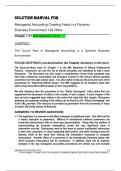Exam (elaborations)
Solution Manual for Managerial Accounting Creating Value in a Dynamic Business Environment 13th Edition by Ronald Hilton and David Platt
- Course
- Institution
Solution Manual for Managerial Accounting Creating Value in a Dynamic Business Environment 13th Edition by Ronald Hilton and David Platt
[Show more]



